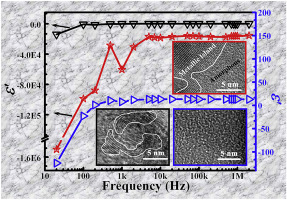Polymer ( IF 4.1 ) Pub Date : 2019-12-28 , DOI: 10.1016/j.polymer.2019.122129 Xiaojiang Xu , Qiangang Fu , Hongbo Gu , Ying Guo , Heng Zhou , Jiaoxia Zhang , Duo Pan , Shide Wu , Mengyao Dong , Zhanhu Guo

|
Herein, we report the preparation of polyaniline (PANI) crystalline nanostructures and their dependent negative permittivity. By controlling the types of doped acids and the doping levels, PANI nanostructures with different crystallinity degrees are synthesized and composed of alternating metallic islands and amorphous regions confirmed by high resolution transmission electron microscopy (HRTEM). It's found that 0.15 mol L−1 of p-toluenesulfonic acid (PTSA) as doped acid is the optimal concentration to achieve a proper molecular weight (226,904 g mol−1) and higher degree of crystallinity (33.4%) from X-ray diffraction (XRD) for PANI. With further increasing the concentration of PTSA to 0.30 mol L−1, the degree of crystallinity (37%) of PANI has little changes, but its molecular weight is quickly decreased to 35,102 g mol−1. As a consequence, the electrical conductivity of PANI increases from 1.1 × 10−3 S cm−1 for poly (2-acrylamido-2-methyl-1-propanesulfonic acid) (p-AMPS) to 6.9 S cm−1 for PTSA and the PANI crystalline nanostructures doped with PTSA and hydrochloric acid possess a negative permittivity within the measured frequency range of 20 Hz to 2 MHz, whereas the permittivity for PANI doped with perchloric acid, phosphoric acid, camphorsulfonic acid, and p-AMPS switches from negative at low frequency to positive at high frequency. By calculation from AC conductivity, the charge carrier transport in these PANI systems follows the polaron hopping transport mechanism.
中文翻译:

聚苯胺晶体纳米结构依赖的负介电常数超材料
在本文中,我们报告了聚苯胺(PANI)晶体纳米结构的制备及其相关的负介电常数。通过控制掺杂酸的类型和掺杂水平,可以合成具有不同结晶度的PANI纳米结构,该结构由交替的金属岛和无定形区域组成,并通过高分辨率透射电子显微镜(HRTEM)进行了确认。发现以0.15 mol L -1的对甲苯磺酸(PTSA)作为掺杂酸是通过X射线衍射获得合适分子量(226,904 g mol -1)和更高结晶度(33.4%)的最佳浓度。(XRD)表示PANI。随着PTSA的浓度进一步增加至0.30 mol L -1,PANI的结晶度(37%)几乎没有变化,但是其分子量迅速降低至35,102g mol -1。结果,PANI的电导率从聚(2-丙烯酰胺基-2-甲基-1-甲基磺酸)(p -AMPS)的1.1×10 -3 S cm -1增加到PTSA和6.9 S cm -1。掺杂PTSA和盐酸的PANI晶体纳米结构在20 Hz至2 MHz的测量频率范围内具有负介电常数,而掺杂高氯酸,磷酸,樟脑磺酸和p的PANI的介电常数-AMPS从低频的负值切换到高频的正值。通过交流电导率计算,这些PANI系统中的载流子传输遵循极化子跳跃传输机制。









































 京公网安备 11010802027423号
京公网安备 11010802027423号